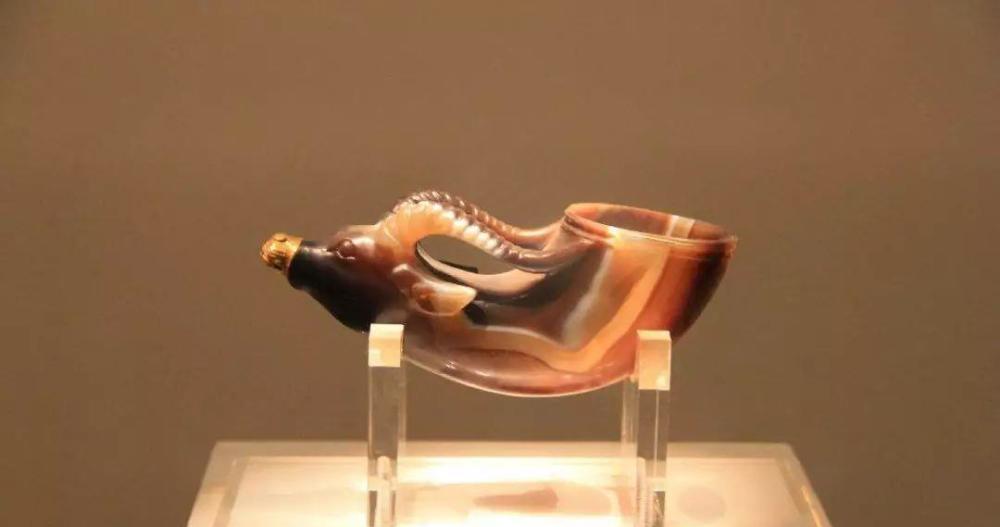#Shaanxi Provincial Museum #Shaanxi is a major province of cultural relics, and the museum in the province has many national treasure-level cultural relics, and the animal head agate cup is one of them. It is also called the beast head horn cup, which is not only the treasure of the town hall of the Shaanxi History Museum, but also the treasure of the country. What is its cultural value? What kind of mystery of life is hidden behind such a ingenious treasure?

The full name of the beast head horn cup is the gold-encrusted beast head agate cup, but in fact it is not known what material it is made of, it is a unique product at home and abroad, and now it is not even found in the world to make its similar materials. Although the beast head horn cup was excavated in the Tang Dynasty cultural relics group, it is not necessarily a product of the Tang Dynasty, but should be a collection of Cultural Exchanges between China and foreign countries in the Tang Dynasty. The Beast Head Horn Cup is one of the most important cultural relics that the state does not allow to go abroad for exhibition.
The Beast Head Horn Cup was discovered in the village of Hejia in the 1970s. At that time, archaeologists found a small silver jar next to a clay urn, and the horn cup of the beast's head lay in it.
Readers who have been to the museum may remember the ingenious craftsmanship of this beast-headed agate cup. The jade master carved a delicate animal head at the small end of the jade, and carved the thick end of the vertical texture into a cup mouth, and there were exactly two round and convex strings on the outside of the mouth, and the lines were smooth and natural, seamless. The author cleverly uses the technique of pretty color to portray the animal's eyes in black and white, and the shape of the god Bixiao really achieves the effect of "finishing touches". The two horns are thick and powerful, showing a strong dynamic beauty, the ears are high up, slightly adducted, as if listening to the sound of the world, the shape and dynamics of the whole cup, describing the moment when the galloping beast rushes forward with full concentration, which is heartwarming.
This beast-headed agate cup is 6.5 cm high, 15.6 cm long and 5.9 cm in diameter, and is used for drinking wine. It is carved from a whole piece of agate, which is the only beautiful jade carving of the Tang Dynasty that has been seen so far, and it is also the most exquisite piece of jade workmanship in the Tang Dynasty.
Mysterious Origins: Is it a tribute or the work of a local craftsman?
It is said that similar items have been unearthed in Russia, but they are not as beautiful as ours, and there is no white pattern on the cup. From the silhouette point of view, this curved wine glass resembles the horn of the beast, so it is also called the horn cup. So what kind of mysterious life does this treasure have?
Some experts believe that this national treasure, symbolizing wealth and power, is a noble work of art, and it is also likely that a certain country in Central and Western Asia entered the Tang Dynasty' state ceremony, which is of extraordinary significance.
According to reports, this form originated in the West, the Greeks called it "rhyton", and later spread to Asia. Therefore, some scholars speculate that this cup is a gift from Central asia or West Asia. But in-depth researchers firmly believe that this cup came from the hands of the Tang Dynasty. At the beginning of the production, the Beast Head Cup may also want to simulate the Western fashion to adopt the shape of antelope, but due to the unfamiliarity with the subject matter, it has finally become the current face.
It is estimated to have been made in the early eighth century. Therefore, this precious agate cup is likely to have come to China from the Western Regions as a messenger of cultural exchange, but it is not excluded that it was written by craftsmen living in Central asia or West Asia who lived in Chang'an, or that Tang Dynasty craftsmen learned foreign crafts and used foreign tribute materials to make masterpieces.
For more exciting content, come and pay attention to Jingge to talk about antiques